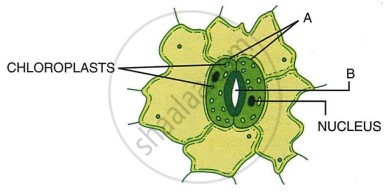Advertisements
Advertisements
Question
How will you differentiate the different types of transpiration?
Solution
There are three types of transpiration:
Stomatal transpiration: Loss of water from plants through stomata. It accounts for 90- 95% of the water transpired from leaves.
Cuticular transpiration: Loss of water in plants through the cuticle.
Lenticular transpiration: Loss of water from plants as vapour through the lenticels. The lenticels are tiny openings that protrude from the barks in woody stems and twigs as well as in other plant organs.
But transpiration is necessary for the following reasons.
- It creates a pull in leaf and stem.
- It creates an absorption force in roots.
- It is necessary for continuous supply of minerals.
- It regulates the temperature of the plant.
APPEARS IN
RELATED QUESTIONS
Name the following:
openings on the stem through which transpiration occurs.
Given ahead is the diagram of an experimental set up to study the process of transpiration in plants. Study the same and then answer the questions that follow:

Is the experimental leaf a monocot or a dicot? Give a reason to support your answer.
Where are stomata generally found?
Differentiate Between Stomata and Hydathodes.
Given below is an apparatus used to study a particular process in plants. Study the same and answer the questions that follow :

(i) Name the apparatus.
(ii) Mention one limitation of this apparatus.
(iii) Which phenomenon is studied with the help of this apparatus?
(iv) What is the function of the part marked ‘reservoir’?
(v) What is the role of the air bubble in the experiment?
Draw a labeled diagram of the stomatal apparatus and label the following in it: Stoma, Guard cells, Chloroplast, Epidermal cells, and Cell wall.
Suppose you have a rose plant growing in a pot, how will you demonstrate transpiration in it?
Define the following term:
Cuticle
Given below is the figure of a stoma. Study the same and answer the following questions:

- Label the guidelines A and B.
- Write the exact location of the above-mentioned structures.
- Mention one important role of structure A.
- Write three important roles for structure B.
- Redraw the same figure when structures A are in flaccid condition. When does the flaccid condition occur?
